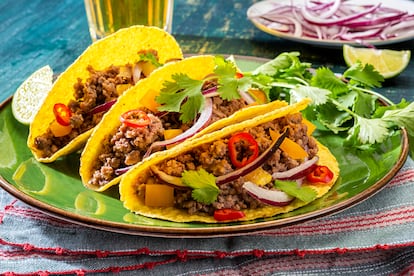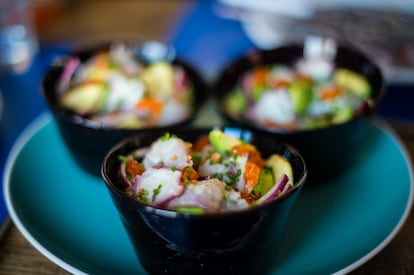Savoring success: Latin American cuisine in the United States
From humble street-side taco stands to Michelin-starred restaurants, the love of this food only continues to grow in the U.S.

A smorgasbord of regional cuisines with unique flavors
Latin America is home to a diverse array of regional cuisines, from Mexican to Ecuadorian, Peruvian to Argentine. Each has its unique flavors and ingredients, brought about by the fusion of indigenous, European, African and Asian influences that shaped Latin America’s history. Take, for example, the Peruvian lomo saltado, a mouth-watering fusion of Spanish, Chinese, and indigenous flavors with stir-fried beef, vegetables, and potatoes served with rice. Or the savory and spicy Venezuelan and Colombian arepas, which showcases the cuisine’s pre-Columbian roots with a corn-based bread, filled with a variety of ingredients like cheese, meat, beans and avocado.
The Latin American journey to plates in the US
Even before becoming part of the United States, certain Latin American culinary traditions had already established themselves in Florida and various western states. Meanwhile, others made their way into the country, starting with the initial wave of migration from countries such as Mexico, Cuba, and Puerto Rico in the mid-20th century.
Avocados, quinoa and plantains — just a few staples of Latin American cuisines — have now become commonplace in many American pantries. According to Statista, the U.S. per capita consumption of fresh avocados amounted to approximately 8.43 pounds in 2021, up from 2.2 pounds in 2000. Quinoa, a flavorful grain from the Andes, has also seen a remarkable rise in popularity due to its health benefits and versatility in recipes.

“These days, tortillas outsell burger and hot dog buns; sales of tortilla chips trump potato chips; and tacos and burritos have become so ubiquitously ‘American,’ most people don’t even consider them ethnic,” wrote journalists Suzette Laboy and J.M. Hirsch. It’s just another indicator of the changing demographics in a country that is nearly 20% Hispanic.
As the New York Times reported way back in 1992: “Ketchup, long the king of American condiments, has been dethroned. Last year, salsa ... took the condiment crown, outselling ketchup by $40 million in retail stores.” David Weiss, the president of New York-based Packaged Facts Inc. told the Times back then that “the taste for salsa is as mainstream as apple pie these days.” Even George Costanza knew this. “You know salsa is the number one condiment in America right now,” he said on a 1992 episode of Seinfeld.
The culinary giants transforming Latin American cuisine
Latin American chefs have made a name for themselves in the United States and around the world, using their talent and passion for their region’s culinary arts to broaden the American palate.
Chef Gastón Acurio has been credited with introducing Americans to the complex flavors of Peru. With his successful chain of La Mar Cebichería Peruana restaurants in San Francisco, New York, and Miami, Acurio has put Peruvian food on the map. Nelson Milan, a food critic for Eater magazine, says: “American palates have evolved so much in recent years thanks to chefs like Gastón Acurio who are introducing us to new flavors, ingredients, and culinary techniques.” Food critic Elise Craig wrote in Condé Nast Traveler magazine: “Cebiche, cebiche, cebiche. It’s what La Mar is known for… If you can only handle one, go for the clasico, the catch of the day with leche de tigre, red onion, habanero, corn, and sweet potatoes.”

Enrique Olvera is perhaps the most famous Mexican chef working today. His Pujol restaurant was ranked #1 in Mexico and #9 in the world at the World’s 50 Best Restaurant Awards. Olvera is a pioneer of a new contemporary Mexican style of food, which uses traditional, local ingredients with unusual flavor combinations. His signature “Mole Madre, Mole Nuevo” consists of two concentric rings of the traditional Mexican mole, one of which is aged for 2,500 days. It’s served alongside a steamy dish of baby corn with chicatana ant mayonnaise. That’s right — ants — with a pleasantly smoky taste and crunchy texture.
Street food
Street food, traditionally less refined but bursting with flavor, has been a significant ambassador of Latin American food culture to the United States. These foods were born out of necessity, innovation and creativity, and often represent the heart and soul of Latin American cuisine. From tacos to empanadas, these simple yet delicious foods have won the hearts and palates of many Americans.
Tacos from Mexico have certainly taken center stage in the American street food scene. These humble yet flavorful soft tortillas are filled with everything from pork, beef and chicken, to vegan options like beans and grilled vegetables. Garnished with fresh cilantro, onions, and a squeeze of lime, it’s hard to resist them. National Taco Day, celebrated on October 4 every year, is a concentrated version of the “Taco Tuesdays” many restaurants offer in a bid to bring in crowds.
Similarly, empanadas, baked or fried pastries filled with meat, cheese, or other ingredients, have become a go-to snack or meal for many Americans. Brought by immigrants from various countries like Argentina, Colombia and Chile, each version of this dish brings with it a unique twist whether it’s the dough, the filling, or the method of cooking. These handheld delights are perfect for on-the-go eating and have found their place in food trucks, local shops, and even in gourmet restaurants across the United States.

Tex-Mex food, a fusion of Mexican and American cuisines, has become a beloved part of the culinary landscape in the United States. Its origins can be traced back to the Tejanos, inhabitants of Texas when it was part of Mexico. Over time, as cultural exchanges occurred between Mexican immigrants and Americans, a new flavor profile emerged that was distinct yet deeply rooted in its Mexican ancestry. Today, Tex-Mex is recognized for its heavy use of shredded cheese, meat (particularly beef and pork), beans, and spices, with dishes like nachos, hard-shell tacos, and chili con carne becoming synonymous with this cuisine.
Pupusas, the national dish of El Salvador, have steadily gained popularity in the United States over the past few years. These thick, hand-made corn tortillas stuffed with a variety of fillings such as cheese, pork, or beans, offer an exciting addition to the American culinary scene. Pupusas are traditionally served with a tangy, fermented cabbage slaw called curtido and a thin tomato sauce, providing a flavorful punch with each bite. The unique taste and texture of pupusas have caught the attention of food lovers, and their widespread appeal is evident in the growing number of Salvadoran restaurants and food trucks across the country. In 2005, the city of Los Angeles — home to a large Salvadoran community — declared a National Pupusa Day, further cementing the popularity of this dish.
The future of Latin American cuisine
As the appetite for Latin American cuisine continues to grow, so does its influence in U.S. restaurants. From trendy taco stands to upscale eateries, there is an increasing demand for chefs that specialize in Latin American recipes, and more are entering the culinary scene every day. Chefs and food truck cooks are also experimenting with Latin American flavors, using them in unexpected ways, like the Korean tacos popular in many parts of the United States. Korean-style fillings like bulgogi marinated beef and spicy kimchi vegetables fill the traditional Mexican corn tortillas.
Latin American cuisine is here to stay and it is only going to get better. From traditional dishes that have been passed down through generations to modern fusion creations, Latin American cuisine is sure to continue delighting and surprising the American palate.
Sign up for our weekly newsletter to get more English-language news coverage from EL PAÍS USA Edition
Tu suscripción se está usando en otro dispositivo
¿Quieres añadir otro usuario a tu suscripción?
Si continúas leyendo en este dispositivo, no se podrá leer en el otro.
FlechaTu suscripción se está usando en otro dispositivo y solo puedes acceder a EL PAÍS desde un dispositivo a la vez.
Si quieres compartir tu cuenta, cambia tu suscripción a la modalidad Premium, así podrás añadir otro usuario. Cada uno accederá con su propia cuenta de email, lo que os permitirá personalizar vuestra experiencia en EL PAÍS.
¿Tienes una suscripción de empresa? Accede aquí para contratar más cuentas.
En el caso de no saber quién está usando tu cuenta, te recomendamos cambiar tu contraseña aquí.
Si decides continuar compartiendo tu cuenta, este mensaje se mostrará en tu dispositivo y en el de la otra persona que está usando tu cuenta de forma indefinida, afectando a tu experiencia de lectura. Puedes consultar aquí los términos y condiciones de la suscripción digital.
More information
Archived In
Últimas noticias
There is as much life left to discover on planet Earth as that which is already known
Dozens presumed dead, around 100 injured in fire at Swiss Alps bar during New Year’s celebration
Is porn for women different from conventional porn? We spoke to those who make it
Cartagena de Indias is sinking: What can the city do to mitigate it?
Most viewed
- Reinhard Genzel, Nobel laureate in physics: ‘One-minute videos will never give you the truth’
- David King, chemist: ‘There are scientists studying how to cool the planet; nobody should stop these experiments from happening’
- Oona Chaplin: ‘I told James Cameron that I was living in a treehouse and starting a permaculture project with a friend’
- Sinaloa Cartel war is taking its toll on Los Chapitos
- The Interoceanic Train, the Mexican alternative to the Panama Canal










































